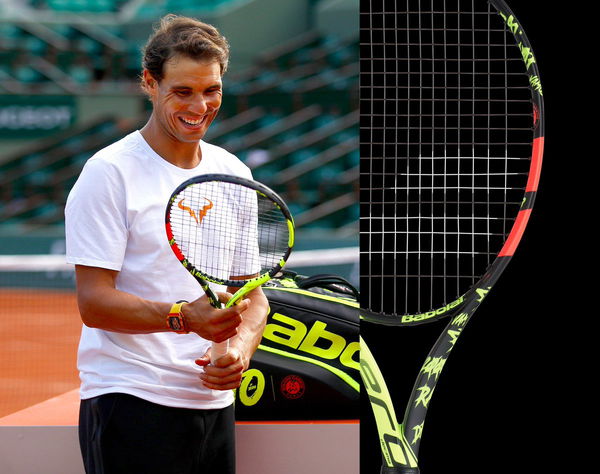
via Imago
Rafael Nadal and his Babolat weapon

via Imago
Rafael Nadal and his Babolat weapon
The woven network of a tennis racquet is the predominant portion which comes in contact with the tennis ball and allows the professionals to strike the ball efficiently on their opponent’s court. The professionals change tennis racquet strings frequently in order to obtain standardized tension in their racquets throughout the match.

via Imago
How Often Do Players Change Tennis Racquet Strings?
Back in the 19th century, the first-ever lawn tennis racquet was strung with the outer skin of sheep intestine known as a serosa. Those strings are termed as natural gut tennis strings. It offered optimum elasticity, flexibility, and retention of tension. With the evolution in the sport, the hybrid strings on the tennis racquets are extensively used now.
ADVERTISEMENT
Article continues below this ad
‘Every point in tennis counts’, this drives the professionals to periodically change tennis racquet strings. The spectators seldom witness the players’ racquets strings being broken in the midst of a match. And that is because they change tennis racquet strings on a regular basis.

via Imago
Serena Williams, How Often Do Top Players Change Tennis Racquet Strings?
“It’s very rare, you see me breaking a string because I try not to get to the point where I break it. I change them after every match because it could be a super important point in the match. So, every point in tennis counts,” says Serena Williams.
The professionals a quite meticulous regarding the change in tennis racquet strings, in fact even for their practice sessions in order to get optimum tension the restring it from training to training. “For every practice and for every match, I use new strung racquets. I do actually learn the tensions that I get and more natural power,” says Caroline Wozniacki.

via Imago
Rafael Nadal, How Often Do Top Players Change Tennis Racquet Strings?
Rafael Nadal uses the strings with a tension of around 25 kilos, he changes them every day and prevents it’s breaking and also to exercise his control favorably on the court. “I strung almost every day, if not I break the strings or try to change it before,” says Rafa.
ADVERTISEMENT
Article continues below this ad
It is inevitable for professionals to change tennis racquet strings because the fluctuation in the tension of the racquet would radically have an impact in their game due to variance in the power of their groundstrokes, serves and slices. “As the strings stay in there, they get more dead as well. So you lose a little bit of feel which counteracts the looseness of the strings”, said Kevin Anderson.

via Imago
Kevin Anderson, How Often Do Top Players Change Tennis Racquet Strings?
“We are changing so often, the sceneries and the conditions and most of them have three, four different tensions in the racquet,” says Marin Cilic.
ADVERTISEMENT
Article continues below this ad
When they feel, their racquet isn’t producing their natural game or they don’t feel in the same way as always, that’s when they realize its the time to change tennis racquet strings. “I like to replace them once every two days in practice. When I feel they have lost a lot of tension and I feel like the ball is trying to sail on me and that’s when I know I need a switch”, says Denis Shapovalov.
ADVERTISEMENT
ADVERTISEMENT
ADVERTISEMENT
ADVERTISEMENT

